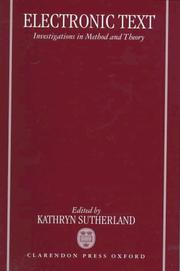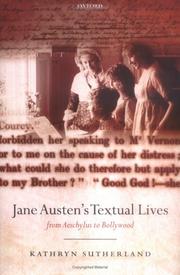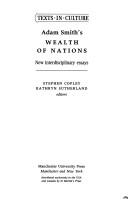| Listing 1 - 10 of 16 | << page >> |
Sort by
|

ISBN: 0198236638 0191679313 Year: 1997 Publisher: Oxford : Clarendon press,
Abstract | Keywords | Export | Availability | Bookmark
 Loading...
Loading...Choose an application
- Reference Manager
- EndNote
- RefWorks (Direct export to RefWorks)
Graphics industry --- English literature --- Information systems --- Edition électronique --- Electronic publishing --- Elektronisch uitgeven --- Tekstverwerking (Informatica) --- Text processing (Computer science) --- Traitement de textes (Informatique) --- 681.3*I7 --- 82.083 --- American literature --- -Electronic publishing --- -Manuscripts, American --- -Manuscripts, English --- -Text processing (Computer science) --- Transmission of texts --- -Literary transmission --- Manuscript transmission --- Textual transmission --- Criticism, Textual --- Editions --- Manuscripts --- Processing, Text (Computer science) --- Database management --- Electronic data processing --- Information storage and retrieval systems --- Word processing --- English manuscripts --- American manuscripts --- British literature --- Inklings (Group of writers) --- Nonsense Club (Group of writers) --- Order of the Fancy (Group of writers) --- Digital publishing --- Online publishing --- Publishers and publishing --- Desktop publishing --- Agrarians (Group of writers) --- Text processing (Computing methodologies)--See also {681.3*H4} --- Teksteditie. Editiewetenschap --- -Data processing --- Editing --- Data processing --- Literature publishing --- Manuscripts, American --- Manuscripts, English --- Data processing. --- -Text processing (Computing methodologies)--See also {681.3*H4} --- 82.083 Teksteditie. Editiewetenschap --- 681.3*I7 Text processing (Computing methodologies)--See also {681.3*H4} --- Text processing (Computer science). --- -Processing, Text (Computer science) --- Literary transmission --- Literary publishing --- Literature --- Criticism, Textual&delete& --- Editing&delete& --- Publishing --- Criticism [Textual ] --- Manuscripts [American ] --- Manuscripts [English ]

ISBN: 9780199258727 9780199234288 0199258724 Year: 2011 Publisher: Oxford Oxford University Press
Abstract | Keywords | Export | Availability | Bookmark
 Loading...
Loading...Choose an application
- Reference Manager
- EndNote
- RefWorks (Direct export to RefWorks)
Through three intertwined histories Jane Austen's Textual Lives offers a new way of approaching and reading a very familiar author. One is a history of the transmission and transformation of Jane Austen through manuscripts, critical editions, biographies, and adaptations; a second provides a conspectus of the development of English Studies as a discipline in which the original and primary place of textual criticism is recovered; and a third reviews the role of Oxford University Press in shaping a canon of English texts in the twentieth century. Jane Austen can be discovered in all three. Since her rise to celebrity status at the end of the nineteenth century, Jane Austen has occupied a position within English-speaking culture that is both popular and canonical, accessible and complexly inaccessible, fixed and certain yet wonderfully amenable to shifts of sensibility and cultural assumptions. The implied contradiction was represented in the early twentieth century by, on the one hand, the Austen family's continued management, censorship, and sentimental marketing of the sweet lady novelist of the Hampshire countryside; and on the other, by R. W. Chapman's 1923 Clarendon Press edition of the Novels of Jane Austen, which subjected her texts to the kind of scholarly probing reserved till then for classical Greek and Roman authors obscured by centuries of attrition. It was to be almost fifty years before the Clarendon Press considered it necessary to recalibrate the reputation of another popular English novelist in this way. Beginning with specific encounters with three kinds of textual work and the problems, clues, or challenges to interpretation they continue to present, Kathryn Sutherland goes on to consider the absence of a satisfactory critical theory of biography that can help us address the partial life, and ends with a discussion of the screen adaptations through which the texts continue to live on. Throughout, Jane Austen's textual identities provide a means
Austen, Jane --- Canon (Literature). --- Austen, Jane, --- Criticism, Textual. --- Adaptations --- History and criticism.

ISBN: 1280759135 9786610759132 0191555363 1423770951 9780191555367 9781280759130 0199258724 6610759138 9781423770954 1383040060 9780199258727 Year: 2023 Publisher: Oxford : Oxford University Press,
Abstract | Keywords | Export | Availability | Bookmark
 Loading...
Loading...Choose an application
- Reference Manager
- EndNote
- RefWorks (Direct export to RefWorks)
A critical study of Jane Austen, this work discusses the ways her texts and her reputation have been constructed from manuscript, in the printing process, through editing, family censorship and continuations, biographical invention, and film adaptations.
Canon (Literature) --- English Literature --- English --- Languages & Literatures --- Classics, Literary --- Literary canon --- Literary classics --- Best books --- Criticism --- Literature --- History and criticism --- Austen, Jane, --- Criticism, Textual. --- Adaptations --- History and criticism. --- Ao-ssu-ting, --- Ao-ssu-ting, Chien, --- Aosiding, --- Aosiding, Jian, --- Āsṭin̲, Jēn̲, --- Austenová, Jane, --- Osten, Dzheĭn, --- Ostin, Dzhein, --- Lady, --- Author of Sense and Sensibility, --- Остен, Джейн, --- Остен, Джейм, --- אוסטן, ג׳יין --- אוסטן, ג׳יין, --- أوستن، جين، --- Criticism and interpretation.
Book
ISBN: 9780192670342 9780192856517 Year: 2022 Publisher: Oxford Oxford University Press
Abstract | Keywords | Export | Availability | Bookmark
 Loading...
Loading...Choose an application
- Reference Manager
- EndNote
- RefWorks (Direct export to RefWorks)
This is a study of the politics, the commerce, and the aesthetics of heritage culture in the shape of authors' manuscripts. Draft or working manuscripts survive in quantity from the eighteenth century when, with the rise of print, readers learnt to value 'the hand' as an index of individuality and the blotted page, criss-crossed by deletion and revision, as a sign of genius. Since then, collectors have fought over manuscripts, libraries have curated them, the richhave stashed them away in investment portfolios, students have squeezed meaning from them, and we have all stared at them behind exhibition glass. Why do we trade them, conserve them, and covet them? Most, after all, are just the stuff left over after the novel or book of poetry goes into print. Poisedon the boundary where precious treasure becomes abject waste, litter, and mess, modern literary manuscripts hover between riches and rubbish.In a series of case studies, this book explores manuscript's expressive agency and its capacity to provoke passion--a capacity ever more to the fore in the twenty-first century now that books are assembled via word-processing software and authors no longer leave in such quantity those paper trails behind them. It considers manuscripts as residues of meaning that print is unable to capture: manuscript as fragment art, as property, as waste paper. It asks what it might mean to re-read print inthe shadow of manuscript. Case studies of Samuel Johnson, James Boswell, Walter Scott, Frances Burney, and Jane Austen--writers from the first great period of manuscript survival--are interspersed with discussions of William Godwin's record keeping, the Cairo genizah, Katie Paterson's 'Future Library'project, Andy Warhol's and Muriel Spark's self-archiving, Cornelia Parker's reclamation art, and more.
091 "18" --- 091 =20 --- 091 "18" Handschriftenkunde. Handschriftencatalogi--19e eeuw. Periode 1800-1899 --- Handschriftenkunde. Handschriftencatalogi--19e eeuw. Periode 1800-1899 --- 091 =20 Handschriftenkunde. Handschriftencatalogi--Engels --- Handschriftenkunde. Handschriftencatalogi--Engels --- Conservation. Restoration --- Manuscripts. Epigraphy. Paleography
Book
ISBN: 0191946915 0192670344 0192670352 0192856510 Year: 2022 Publisher: Oxford Oxford University Press USA - OSO
Abstract | Keywords | Export | Availability | Bookmark
 Loading...
Loading...Choose an application
- Reference Manager
- EndNote
- RefWorks (Direct export to RefWorks)
Book
ISBN: 331961830X 3319618296 Year: 2018 Publisher: Cham : Springer International Publishing : Imprint: Springer,
Abstract | Keywords | Export | Availability | Bookmark
 Loading...
Loading...Choose an application
- Reference Manager
- EndNote
- RefWorks (Direct export to RefWorks)
What does it mean to be starting an academic career in the twenty first century? What challenges and prospects are new academics facing and how are they dealing with these? This book provides answers to these questions through an investigation of the experiences of early career academics in New Zealand universities. Filling a gap in the international literature on the academic profession by providing a comprehensive overview of the experiences of New Zealand academics, the book includes research findings from a national survey covering all eight New Zealand universities. This research is also compared with various findings from the 2007 Changing Academic Profession survey in 19 other countries. The book encourages readers to think about the early career academic experience in New Zealand in relation to their own experiences of the academic profession internationally. Key areas of focus in the nine chapters include: the teaching, research, and service preferences and activities of early career academics; work-life balance; satisfaction; the experiences of Māori academics; and professional development and support for all early career academics. Underpinning the book is the issue of the socialisation of early career academics into the academic profession in the twenty first century, and how structure and agency interact to affect that socialisation. Suggestions are made, and links to freely available online resources are provided, for improving socialisation at the individual, departmental, institutional, and national levels.
Education, Higher --- College students --- Higher education --- Education --- Education. --- International education. --- Comparative education. --- Educational policy. --- ducation and state. --- Higher education. --- Higher Education. --- Educational Policy and Politics. --- International and Comparative Education. --- Postsecondary education --- Universities and colleges --- Education, Higher. --- Education and state. --- International education . --- Education, Comparative --- Global education --- Intellectual cooperation --- Internationalism --- Education policy --- Educational policy --- State and education --- Social policy --- Endowment of research --- History --- Government policy
Book
ISBN: 9780754673071 0754673073 9781315612195 9781317045748 9781317045755 9781138272132 Year: 2009 Publisher: Farnham Ashgate
Abstract | Keywords | Export | Availability | Bookmark
 Loading...
Loading...Choose an application
- Reference Manager
- EndNote
- RefWorks (Direct export to RefWorks)
Traditional critical editing, defined by the paper and print limitations of the book, is now considered by many to be inadequate for the expression and interpretation of complex works of literature. At the same time, digital developments are permitting us to extend the range of text objects we can reproduce and investigate critically - not just books, but newspapers, draft manuscripts and inscriptions on stone. Some exponents of the benefits of new information technologies argue that in future all editions should be produced in digital or online form. By contrast, others point to the fact that print, after more than five hundred years of development, continues to set the agenda for how we think about text, even in its non-print forms. This important book brings together leading textual critics, scholarly editors, technical specialists and publishers to discuss whether and how existing paradigms for developing and using critical editions are changing to reflect the increased commitment to and assumed significance of digital tools and methodologies.
Graphics industry --- Literature --- Criticism, Textual --- Editing --- Electronic publishing --- Transmission of texts --- 655.41:681.3 --- 82.083 --- Literary transmission --- Manuscript transmission --- Textual transmission --- Editions --- Manuscripts --- Digital publishing --- Online publishing --- Publishers and publishing --- Desktop publishing --- Authorship --- Textual criticism --- 82.083 Teksteditie. Editiewetenschap --- Teksteditie. Editiewetenschap --- 655.41:681.3 Electronic publishing --- Epic poetry, Greek Criticism, Textual

ISBN: 0719039436 Year: 1995 Publisher: Manchester Manchester University Press
Abstract | Keywords | Export | Availability | Bookmark
 Loading...
Loading...Choose an application
- Reference Manager
- EndNote
- RefWorks (Direct export to RefWorks)
Book
ISBN: 9780192817969 0192817965 Year: 1993 Publisher: Oxford: Oxford university press,
Abstract | Keywords | Export | Availability | Bookmark
 Loading...
Loading...Choose an application
- Reference Manager
- EndNote
- RefWorks (Direct export to RefWorks)
Book
ISBN: 9780754670162 Year: 2008 Publisher: Farnham Ashgate
Abstract | Keywords | Export | Availability | Bookmark
 Loading...
Loading...Choose an application
- Reference Manager
- EndNote
- RefWorks (Direct export to RefWorks)
| Listing 1 - 10 of 16 | << page >> |
Sort by
|

 Search
Search Feedback
Feedback About UniCat
About UniCat  Help
Help News
News